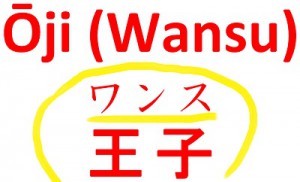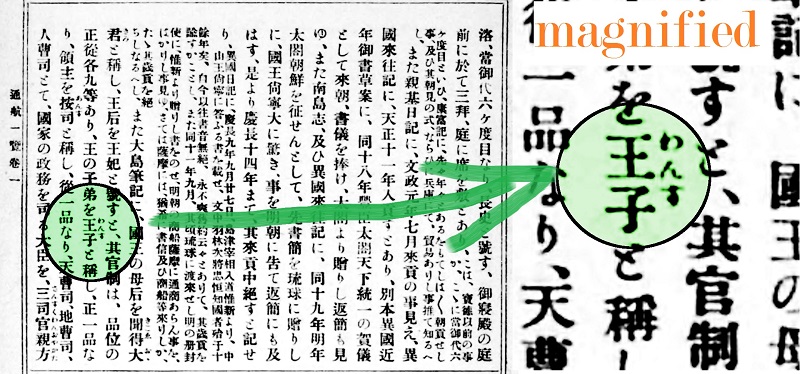The Tsūkō Ichiran (Survey of Foreign Relations, 1853) extensively reports on Ryūkyū. It notes on the first Edo-nobori (embassies to Edo) that took place in 1634. At that time King Shō Hō dispatched prince Kin Ōji Chōtei as a gratitude envoy for enthronement. The reading of his title Ōji here was given as Wansu.
 About forty years later, in 1683 the Chinese embassy for the investiture of Shō Tei reached Ryūkyū. Deputy envoy of this investiture mission was Wang Ji, an Examiner of the Imperial Hanlin Academy who later even participated in the compilation of the Ming annals. Following his return Wang Ji published the Shi Liuqiu Zalu or “Various Records of the Ambassador about Ryukyu” (1686).
About forty years later, in 1683 the Chinese embassy for the investiture of Shō Tei reached Ryūkyū. Deputy envoy of this investiture mission was Wang Ji, an Examiner of the Imperial Hanlin Academy who later even participated in the compilation of the Ming annals. Following his return Wang Ji published the Shi Liuqiu Zalu or “Various Records of the Ambassador about Ryukyu” (1686).
It is sometimes said that the Kata called Wanshū/Wansu is a reference to this Wang Ji, as noted by Sakagami Ryusho (1978) and Kinjo (1999) and others. According to Gima (1986), however, Wanshū/Wansu might have been introduced by Go Kenki and To Daiki, that is, in the early 20th century. See also the various explanation attempts of Wanshū at Wikipedia, which are quite entertaining. In fact, as can be seen in Funakoshi’s 1922 and 1925 books, Wanshū was originally written in phonetic script only. Nobody remembered the original Kanji and all attempts to explain them are simply retrospectively assigned to somehow phonetically fit while at the same time to make “some sense” either technically, or as a historical reference.
I have already noted on ambassador Wang Ji and his possible relation to martial arts in my “Karate 1.0” (2013: 398-99) and although there are hints to martial arts, so far no relation of Wang Ji to the Kata called Wanshū/Wansu could be verified.
However, another possible explanation based on historical source material is as follows.
 The Tsūkō Ichiran (Survey of Foreign Relations, 1853) extensively reports on Ryūkyū. Among others, it describes the various levels of official titles and ranks of the Ryūkyū government organization. To each of the Ryūkyū-specific titles in Kanji was added the pronunciation of the characters written in phonetic syllable. In this way, a Japanese reader knew how to pronounce the word.
The Tsūkō Ichiran (Survey of Foreign Relations, 1853) extensively reports on Ryūkyū. Among others, it describes the various levels of official titles and ranks of the Ryūkyū government organization. To each of the Ryūkyū-specific titles in Kanji was added the pronunciation of the characters written in phonetic syllable. In this way, a Japanese reader knew how to pronounce the word.
I would like to draw your attention to the title of Ōji (prince) in the description below.
- The Ōshima Hikki (1762) reports that the king’s mother is called Kikoe Ōgimi and that the governmental organization knows nine dignitaries. The king’s sons are called Ōji (Wansu) and bear the 1st major rank. Feudal lords are called Anji (Ansu) and have the 1st minor rank. Tenzōshi, Chizōshu, und Jinzōshu (Heaven, earth, and man department) are the three ministers who pursue the political affairs of the country. They are jointly referred to as Sanshikan Uēkata and bear the 2nd major rank. The ministers under them are called Uēkata and bear the 2nd minor rank. The military officers (Bukan 武官) called Pēchin bear the 3rd to 7th rank. They are followed by the donzels called Satonushi in the 8th rank and finally the Chikudun in the 9th rank. This classification is based on the organization of lords and subjects of the Ming Dynasty.
In other words, the Kata name Wanshū/Wansu might have simply referred to the original Ryūkyūan pronunciation of the characters for the title of “prince“.

Tsuko Ichiran, entry showing the pronunciation of “Wansu” for the Ryukyu title of Oji (prince).
See a version of the Tsūkō Ichiran at the National Diet Library Archive.
© 2015 – 2018, Andreas Quast. All rights reserved.
